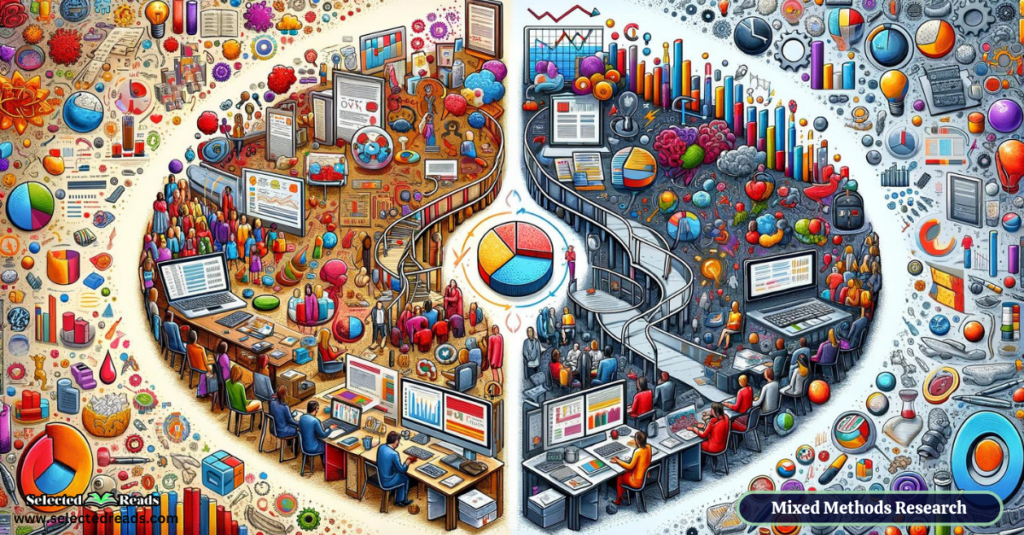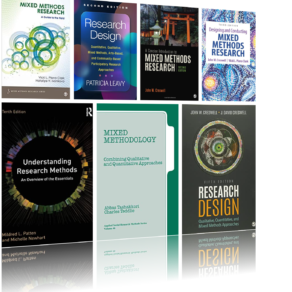As a researcher, I’ve had the privilege of exploring the vast landscape of academic methodologies, all in the pursuit of knowledge. One particular approach has always sparked my curiosity, despite the fact that I have not yet had the opportunity to employ it in my own studies: Mixed Methods Research. I’m drawn to the unique combination of qualitative and quantitative approaches that it employs, creating an interplay of hard data and nuanced narratives.
In this post, I intend to delve into the fascinating world of mixed methods research. I am neither an expert nor a novice, but an avid learner who is intrigued by the promise this method holds. From its conceptual foundation to its practical implications, I’ll embark on a journey to understand its importance, challenges, strengths, and weaknesses. Moreover, I’ll highlight real-life examples from various studies to see how this methodology unfolds in action.
By intertwining different types of data and research paradigms, mixed methods research goes beyond the one-sided perspective, offering a multifaceted insight into the research problem. It seeks to blend the numerical precision of quantitative methods with the descriptive richness of qualitative ones, allowing for a more comprehensive exploration and understanding.
At first glance, this method may seem complex – and truthfully, it is – but I firmly believe that the potential benefits far outweigh the challenges. It enables us to ask broader questions, develop more complete theories, and offer more informed and robust conclusions. It is the embodiment of the saying “the whole is greater than the sum of its parts.”
So, whether you’re a seasoned researcher familiar with this approach, or a student just starting on the academic journey, I invite you to join me in exploring this intricate and compelling research methodology.
Related:
Table of Contents
Definition of Mixed Methods Research
According to Creswell, mixed methods research is “an approach to inquiry that combines or associates both qualitative and quantitative forms. It involves philosophical assumptions, the use of qualitative and quantitative approaches, and the mixing of both approaches in a study”.
Mixed methods research is far more intricate than merely applying both quantitative and qualitative methods within a single study. These research methods are guided by distinct philosophical frameworks. Quantitative research typically originates from a positivist perspective, which focuses on observable and measurable facts, while qualitative research is based on interpretivism, which emphasizes subjective interpretation and understanding.
Therefore, the incorporation of a mixed methodology in your study necessitates research questions that align with both these paradigms. It is not appropriate to use research questions that are solely suited for a quantitative paradigm in a qualitative method context, and vice versa. Your research design and methodology should always reflect the underlying philosophy of your research questions.
The term “mixed methods research” has been widely debated over the last half-century, with several different names being used interchangeably. These terms, according to Creswell include “multitrait/multimethod research,” which refers to the collection of various quantitative methods in a single study, “integrated” or “combined,” implying that two forms of data are merged together, and “quantitative and qualitative methods,” recognizing the blend of methods. Other terms include “hybrids,” “methodological triangulation,” indicative of the convergence of quantitative and qualitative data, “combined research,” and “mixed methodology,” acknowledging it as both a method and a philosophical worldview.
Today, “mixed methods research” is the term most commonly employed, as associated with the “Handbook of Mixed Methods in Social and Behavioral Research.” Though the term may still be unfamiliar to some researchers in the social, behavioral, and human sciences, its frequent usage is promoting its recognition as a distinct methodology and method within a growing scholarly community. See Creswell’ s chapter: Understanding Mixed Methods Research to learn more).
Why Mixed Methods Research is Important
Mixed methods research is increasingly being recognized for its ability to bring together the strengths of both qualitative and quantitative approaches. By blending qualitative and quantitative data, researchers can generate and answer research questions that other methodologies can’t fully address.
As I mentioned earlier, this approach provides a more comprehensive understanding of the research problem than either qualitative or quantitative data alone. It provides breadth and depth of understanding and corroboration, while also allowing for the exploration of new research avenues and the integration of different perspectives. This makes it a particularly effective methodology for tackling complex research questions in a real-world context.
The relevance of mixed methods research has grown due to several factors. The intricate nature of modern research problems necessitates solutions that are more comprehensive than just quantitative numbers or qualitative words alone. The combined use of these data forms enables a more thorough analysis of problems. Researchers can place quantitative data within the context of participants’ words, and conversely, they can use quantitative data to give structure to qualitative responses. Both forms of data are indispensable in today’s research landscape.
The evolution of qualitative research has also reached a stage where it’s recognized as a valid inquiry form in social and human sciences. Quantitative researchers acknowledge the valuable role qualitative data can play in their research. Meanwhile, qualitative researchers understand that only reporting qualitative perspectives of a few individuals may limit the generalizability of their findings. Various stakeholders, including policy makers and practitioners, require multiple forms of evidence to guide and inform their decisions, which further necessitates the amalgamation of quantitative and qualitative data.
Types of mixed methods research
Here are the six types of mixed methods research according to Creswell (2013):
- Sequential Explanatory Design: This design involves two phases, with quantitative data collection and analysis in the first phase, followed by qualitative data collection and analysis in the second phase. The purpose is often to use the qualitative results to help explain or expand on the quantitative results.
- Sequential Exploratory Design: The inverse of the explanatory design, the exploratory design starts with qualitative data collection and analysis, followed by a second phase of quantitative data collection and analysis. This is typically used when there are few preexisting theories or instruments and when the qualitative data can guide subsequent quantitative sampling and analysis.
- Sequential Transformative Design: This design also involves two distinct phases. The emphasis here is on prioritizing a theoretical lens or perspective (such as a feminist or racial equity lens) that guides the project, influencing the purpose, research questions, and methods of data collection and analysis.
- Concurrent Triangulation Design: This design involves the simultaneous collection of qualitative and quantitative data. The data are then compared and contrasts resolved, with the aim of producing well-substantiated conclusions about the research problem.
- Concurrent Embedded Design: In this design, one data type (either quantitative or qualitative) is embedded within a larger, primary methodology. The secondary data set provides a supporting role in the study, enriching the primary data set.
- Concurrent Transformative Design: Here, both qualitative and quantitative data are collected simultaneously but the emphasis is on using a theoretical perspective as the dominant framework guiding the research process and methodologies.
It’s important to note that the best design depends on the researcher’s objectives, the nature of the research problem, and the resources available.
Strengths and weaknesses of mixed methods research
In their research paper, Mixed Methods: A Research Paradigm Whose Time Has Come, Johnson and Onwuegbuzie (2004) outline a number of key strengths and weakness of mixed research. Here is a brief summary of each:
Strengths of mixed methods research
Mixed research methods leverage the strengths of both quantitative and qualitative research, providing a more comprehensive approach. Here are some of the key strengths of mixed research according to Johnson and Onwuegbuzie (2004) :
- They enable the integration of words, pictures, and narratives with numerical data to add meaning, while also using numbers to enhance precision in descriptive data.
- Mixed methods can harness the advantages of both quantitative and qualitative research, enriching the depth and breadth of insights.
- They allow for the generation and testing of a grounded theory, contributing to both theoretical development and empirical validation.
- The use of mixed methods allows for a wider range of research questions to be addressed, as it isn’t limited to a single methodology or approach.
- Different mixed research designs offer specific strengths and weaknesses. For example, in a two-stage sequential design, findings from the first stage inform the purpose and design of the second.
- They allow a researcher to use the strengths of one method to mitigate the weaknesses of another within a single study, creating a more robust research design.
- Mixed methods can provide stronger evidence for conclusions through the convergence and corroboration of findings from different methods.
- They add insights and understanding that might be overlooked if only a single method is used, contributing to a more holistic understanding of the research subject.
- Mixed methods can increase the generalizability of results by diversifying data sources and analytical methods.
- The integration of qualitative and quantitative research provides more complete knowledge, informing both theory and practice in a more comprehensive manner.
Weaknesses of mixed methods research
Despite the many strengths, mixed research methods also come with several potential weaknesses which, according to Johnson and Onwuegbuzie (2004), include:
- Complexity: Conducting both qualitative and quantitative research concurrently can be challenging for a single researcher, often requiring a team to effectively manage the different approaches.
- Learning Curve: A researcher must become proficient in a variety of methods and understand how to appropriately combine them, which requires a significant investment of time and effort.
- Methodological Purity: Some purists argue that researchers should stick strictly to either qualitative or quantitative methodologies, creating potential friction or disagreement in a research team or academic community.
- Cost: Mixed research methods can be more expensive due to the need for multiple data collection tools and possible requirement for a larger research team.
- Time Intensity: The process is more time-consuming as it involves employing and analysing multiple methods.
- Unresolved Issues: Certain aspects of mixed research are still under debate among research methodologists, such as issues related to integrating different paradigms, interpreting conflicting results, and methods of qualitatively analyzing quantitative data.
Mixed Methods Research Examples
Here are a few examples of mixed methods research as provided by Creswell. For more examples, check out my other post entitled: 14 key mixed methods research examples.
Example 1:
In the first set of mixed methods examples, researchers collected data through quantitative instruments and qualitative focus groups. The goal was to corroborate findings from different perspectives. For instance, a quantitative survey could reveal the prevalence of a behavior, while a qualitative focus group could provide insights into the motivations or experiences underlying that behavior. This approach exemplifies mixed methods research by integrating numerical data with narrative data to provide a more comprehensive understanding. Examples of studies include: studies conducted by Black & Ricardo (1994) and Flanagan, McGrath, Meyer, & Garcia Coll (1995),
Example 2:
In studies by Brett et al. (2002) and Donovan et al. (2002), researchers used qualitative data to inform the design of a quantitative experiment. For instance, the researchers might have conducted interviews or focus groups to help refine a treatment protocol or to better understand how to recruit participants for a trial. This illustrates mixed methods research by using qualitative insights to inform the design and execution of quantitative research.
Example 3:
In the studies conducted by Way et al. (1994) and Baumann (1999), the researchers first collected quantitative data through surveys, then conducted qualitative interviews to explore certain survey responses in more depth. This mixed methods approach allows researchers to follow up on interesting or unexpected survey results with a more nuanced exploration of the reasons behind those results.
Example 4:
In the studies conducted by Tashiro (2002) and Ely (1995), the researchers began with qualitative interviews to understand a topic and then used this information to develop a quantitative survey instrument. This sequential mixed methods approach allows researchers to ground their survey instruments in the lived experiences of the population of interest, ensuring that the questions are relevant and meaningful.
Example 5:
In Gogolin & Swartz’s 1992 study, the researchers integrated quantitative and qualitative approaches throughout the entire study. They posed both qualitative and quantitative questions, collected and analyzed both forms of data, and made interpretations from both qualitative and quantitative perspectives. This approach exemplifies mixed methods research by weaving together qualitative and quantitative approaches to provide a robust, multi-faceted understanding of the research question.







